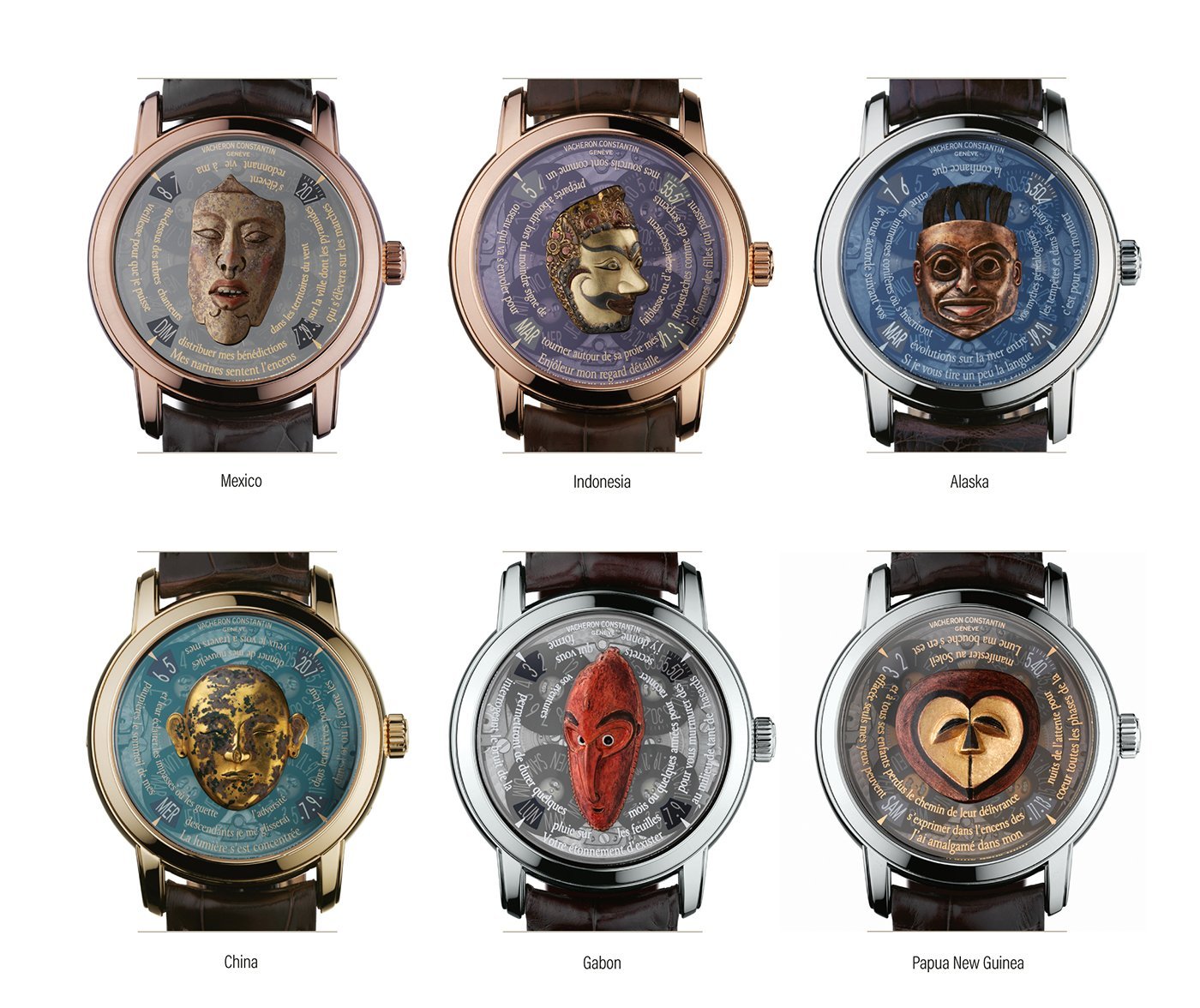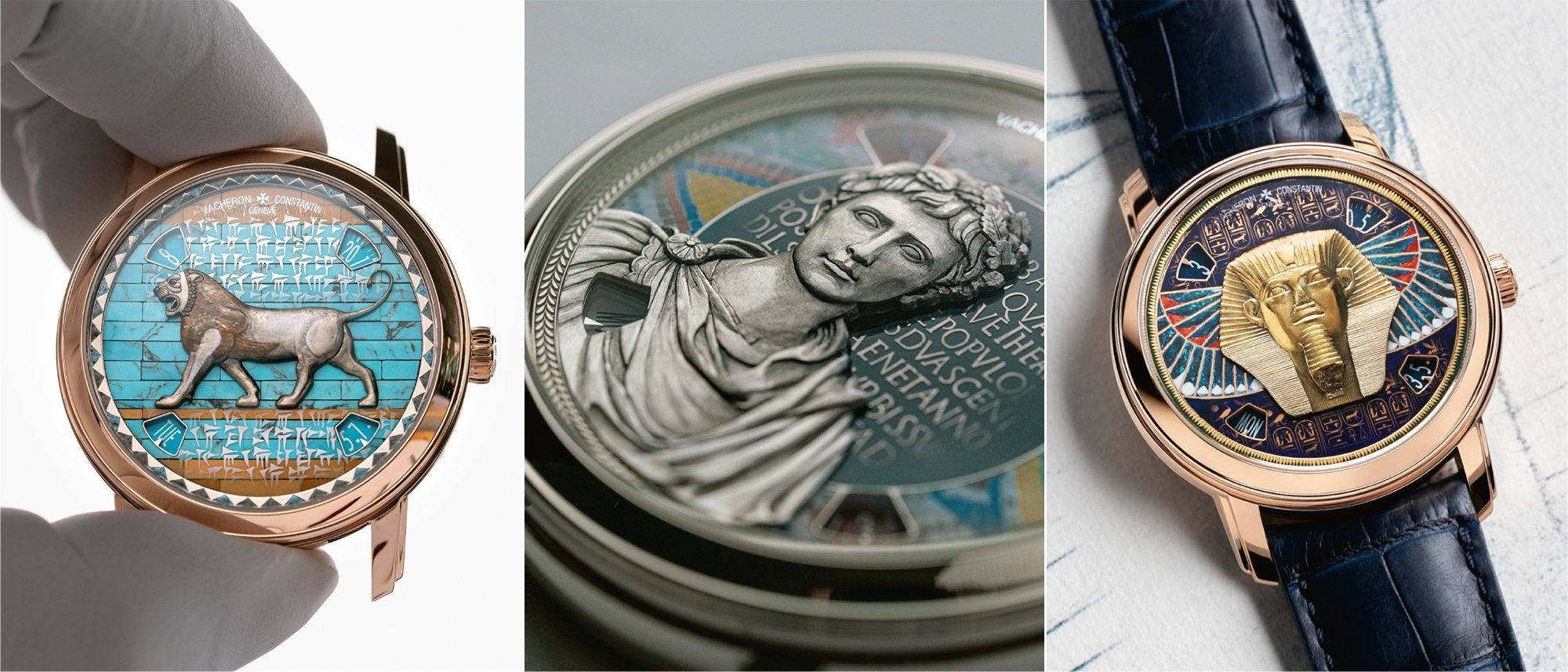his predisposition towards art and culture was already evident in the personalities of Jean-Marc Vacheron and François Constantin. At the age of 24, in 1755, Jean-Marc Vacheron opened his watchmaking atelier in Geneva. His family had come to Geneva –an independent city-state, not yet part of Switzerland – from the canton of Fribourg, and so the young man did not enjoy the same rights as other Geneva citizens. Even so, he identified with the thinking of Rousseau (native to Geneva) and of Voltaire (who lived there), and welcomed the ideas of the Enlightenment, which opened minds to knowledge, science, the arts and the world’s civilisations and cultures.
In 1819 François Constantin joined the business that Jean-Marc Vacheron had founded, and which was now in the hands of his son, Jacques-Barthélémi Vacheron. The Geneva-born son of a merchant, François Constantin was an enterprising businessman who travelled Europe and the world. And what better than the refined timepieces for which Geneva was renowned to open doors in China (as early as 1820), the Middle East and the Americas.
François’ brother, Abraham Constantin, “skilled in portraiture and copies of famous paintings”, excelled in enamel painting. Employed at the prestigious porcelain manufactory in Sèvres, France, he was introduced to the royal household and in 1826 was granted the title of Porcelain Painter to His Majesty the King. After painting a reproduction on porcelain of frescoes by Raphael, for Vicomte de La Rochefoucauld, in 1840 in Florence he published his thoughts on several Italian masterpieces in Idées italiennes sur quelques tableaux célèbres, written with the aid of the great French author, Stendhal.

Thus we can see that the spirit of the Enlightenment, the visual and decorative arts, and an embracing of the world’s cultures and civilisations are embedded in the very foundations of the brand.
Museum partnerships
It follows, then, that Vacheron Constantin should forge alliances with some of the world’s great “encyclopaedic” museums, not forgetting that certain of its timepieces have long been part of important museum collections. These are partnerships in the true sense, extending beyond a patronage or sponsorship agreement. Manufacture and museum establish a collaboration which can take numerous forms but whose purpose is always to convey not just beauty but knowledge, practices and expertise in the métiers d’art.
-

- Detail of Les Cabinotiers minute repeater ultra-thin God of the Wind, a unique piece paying homage to Japanese culture, created in 2022 for the Homo Faber exhibition in Venice.
The first of these partnerships was a collaboration with the Musée Barbier-Mueller in Geneva, which holds a remarkable collection of Indigenous art, followed by the Louvre, the most visited museum in the world and, just recently, the storied Metropolitan Museum of Art in New York (the Met), whose universal collections comprise more than two million works from all over the world.
MUSÉE BARBIER-MUELLER – World cultures
Vacheron Constantin’s collaboration, the first, with the Musée Barbier-Muller gave rise to Métiers d’Art Les Masques. Each year, during an exchange which extended over three years, from 2007 to 2009, a new boxed set of four Les Masques watches was produced as a limited edition of 25. In all, twelve exceptional watches were created, bearing reproductions of twelve masks from the museum’s collections, representing different civilisations.
As an aside, in 2009 the Met hosted the complete set of Les Masques watches as part of a special exhibition in honour of Jean Paul Barbier-Mueller, founder of the eponymous museum.

A powerful and graceful evocation of world cultures, crafted in fine detail, this group of watches was remarkable for the message it conveyed but also for the superlative quality of execution. The masks are hand-sculpted in three dimensions, then further refined and decorated to resemble as closely as possible the originals – which the manufacture’s artisans were able to consult thanks to an exceptional loan by the Musée Barbier-Mueller. Engraved in a spiral on the dial is a poem in prose, composed especially for each mask by French author Michel Butor.
Indigenous art, craftsmanship and poetry come together – with mechanical art – to create twelve timepieces that pay homage to the wealth and diversity of our human adventure.
THE LOUVRE IN PARIS – Safeguarding and sharing knowledge
In 2016 Vacheron Constantin assisted the Musée du Louvre with the restoration of La Création du Monde. Described as “a masterpiece of eighteenth-century precision horology”, this clock was presented to King Louis XV in 1754 – just one year before Jean-Marc Vacheron, who would certainly have been aware of its existence, laid the foundations for the future Vacheron Constantin.
Following on from this initial collaboration, in 2019 Vacheron Constantin entered into a long-term partnership with the prestigious Parisian museum, which was founded in 1793: 38 years after the manufacture. “Born in the Age of Enlightenment, our two institutions share the mission of passing on a passion for art, heritage and the excellence of ancestral craftsmanship,” declared Laurence des Cars, President-Director of the Musée du Louvre. “While firmly rooted in history, they are resolutely open to the contemporary world.”
One of the first manifestations of this partnership was the Bid for the Louvre auction, in December 2020. All the proceeds from the sale went in support of Le Studio, a space inside the Louvre whose workshops make artistic education and practice accessible to all. For the occasion, Vacheron Constantin proposed a unique experience: the successful bidder was invited to personalise the dial of a future Les Cabinotiers timepiece (Les Cabinotiers is the division at Vacheron Constantin specialising in unique pieces) with a reproduction, in enamel miniature painting or grisaille enamel, of a work from the Louvre’s collections. The work would be chosen following a private tour of the museum that included the rare privilege of viewing drawings conserved in the Louvre’s Cabinet des Dessins. A further visit was arranged to discuss the project with the artisans at Les Cabinotiers in Geneva.
The winning bidder chose a work by Peter Paul Rubens, La lutte pour l’étendard de la Bataille d’Anghiar.
Vacheron Constantin’s master enameller drew on his expertise in the technique of grisaille enamel, honed during many years of practice in Limoges, to replicate the emotion of the work in the confines of a dial, in a multitude of interlocking micro-details. To do so, he worked with some twenty shades of brown, grey brown, sepia brown and cream brown, alternating with twenty firings of the piece at 900°C.
The movement is the Manufacture Calibre 2460C, whose oscillating weight is decorated with an engraving of the Louvre’s eastern façade. The hinged officer-type back is hand-engraved with the motto Cerca Trova – “Who seeks (me) finds (me)” – a scholarly allusion to Cosimo de’ Medici, who is portrayed on Rubens’ drawing.
Incidentally, this initiative is now made available by Les Cabinotiers to collectors who wish to recreate a work of their choice from the Louvre collections on the dial of a Métiers d’Art watch.
A tribute to great ancient civilisations
In 2022, again in close collaboration with curators and specialists at the Louvre, a series of Métiers d’Art Tribute to great civilizations watches paid tribute to ancient civilisations through reproductions of four masterpieces conserved at the Louvre. They represent the Persian Empire of Darius the Great, the golden age of Ancient Egypt, the Hellenistic period of Ancient Greece and the rise to power of Augustus, the first Roman emperor.

The centrepiece is a sculpted gold applique on a sapphire crystal which sits on top of the dial, framed by a decorative frieze of Roman mosaics, a painted Egyptian sarcophagus, Greek ceramics and vases and Babylonian-inspired bricks with coloured glazes. These decorations called on contributions from artisans skilled in champlevé enamel, grisaille enamel, stone marquetry, stone micro-mosaic and hand-engraving in the mass.
Vacheron Constantin fitted these watches with its Manufacture Calibre 2460 G4/2 with automatic winding. Hours, minutes, day and date appear in four apertures positioned around the periphery of the dial, leaving the centre free for the métiers d’art to express themselves. This is the same movement that equipped the watches in the Métiers d’Art Les Masques series, in collaboration with Musée Barbier-Mueller.
THE METROPOLITAN MUSEUM OF ART IN NEW YORK – Mentorship
Fresh off the press, in September 2023 Vacheron Constantin announced a partnership for “the safeguarding and passing on of knowledge and expertise” with the Metropolitan Museum of Art (the Met), founded in New York in 1870. Alongside conservation of its permanent collections, this world-famous institution, through its Education Department, presents over 29,000 events and programmes annually, including workshops, art-making experiences, scholarship and research fellowships, as well as high school and college internships.
This commitment to the preservation of knowledge underpins the collaboration between Vacheron Constantin and the Met. The partnership will take the form of various activities, including an artist-in-residency programme, special events and educational initiatives.
-

- New York is certainly an inspiration for Vacheron Constantin, as this Minute Repeater Tourbillon Tribute to Art Deco Style shows. Recently presented by the manufacture, its wood marquetry dial (110 pieces in black-tinted pearwood and blue-tinted tulipwood) references the Chrysler Building, a splendid example of Art Deco architecture, while the sides of the case are hand-engraved with geometric designs that are characteristic of this style.
Vacheron Constantin has already announced future timepieces inspired by artworks from the Met collections. As yet, we can only guess what form these will take but our money is on an Art Deco theme. New York is full of stunning Art Deco buildings and the Met holds an impressive collection of Art Deco objects. In fact Vacheron Constantin frequently delved into this artistic style during the 1920s and 1930s, for watches made specifically for the United States. This is, of course, mere supposition by this journalist… although Les Cabinotiers minute repeater Tribute to Art Deco watch – just released and with no connection to the Met – suggests it may not be far from the truth!


































